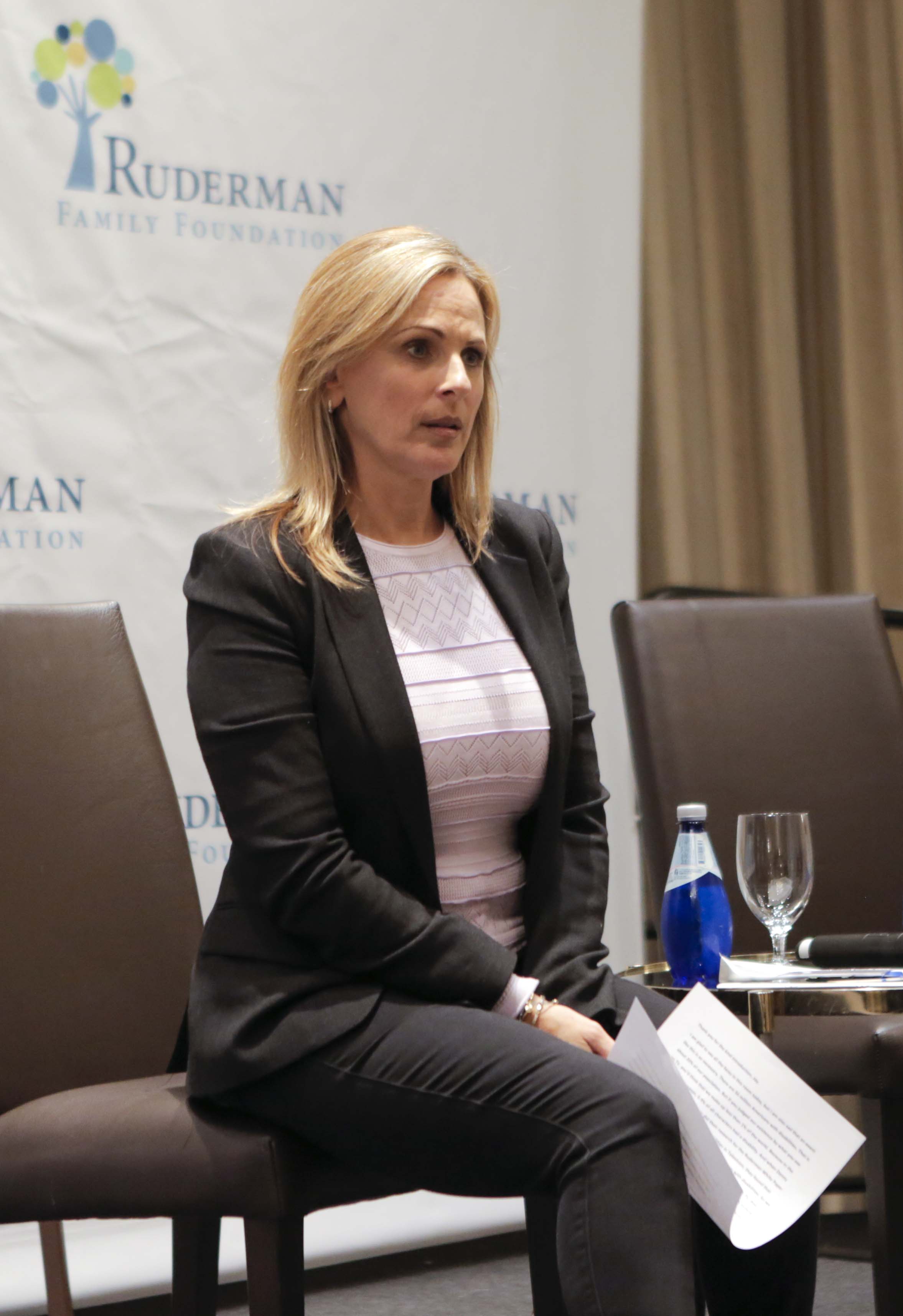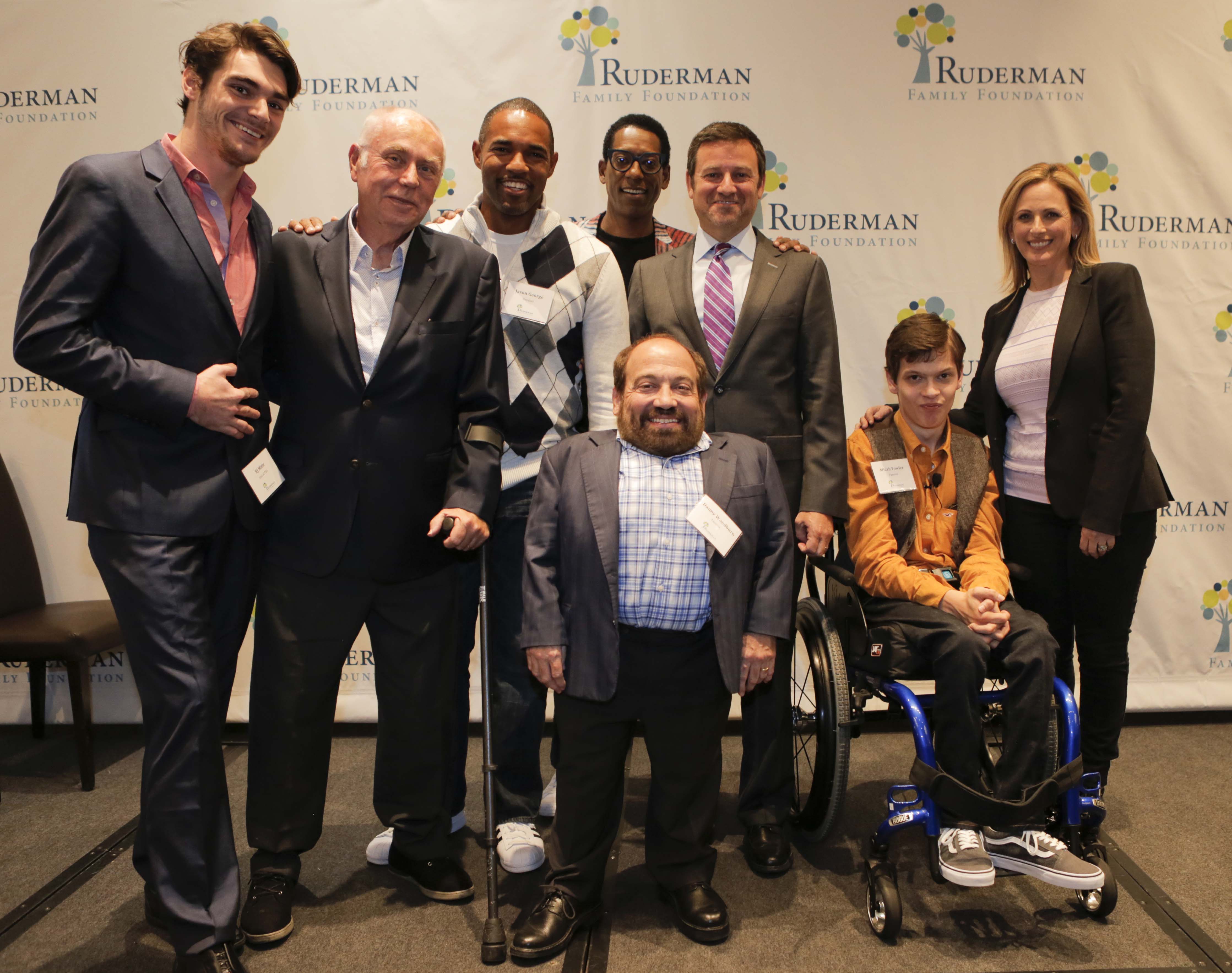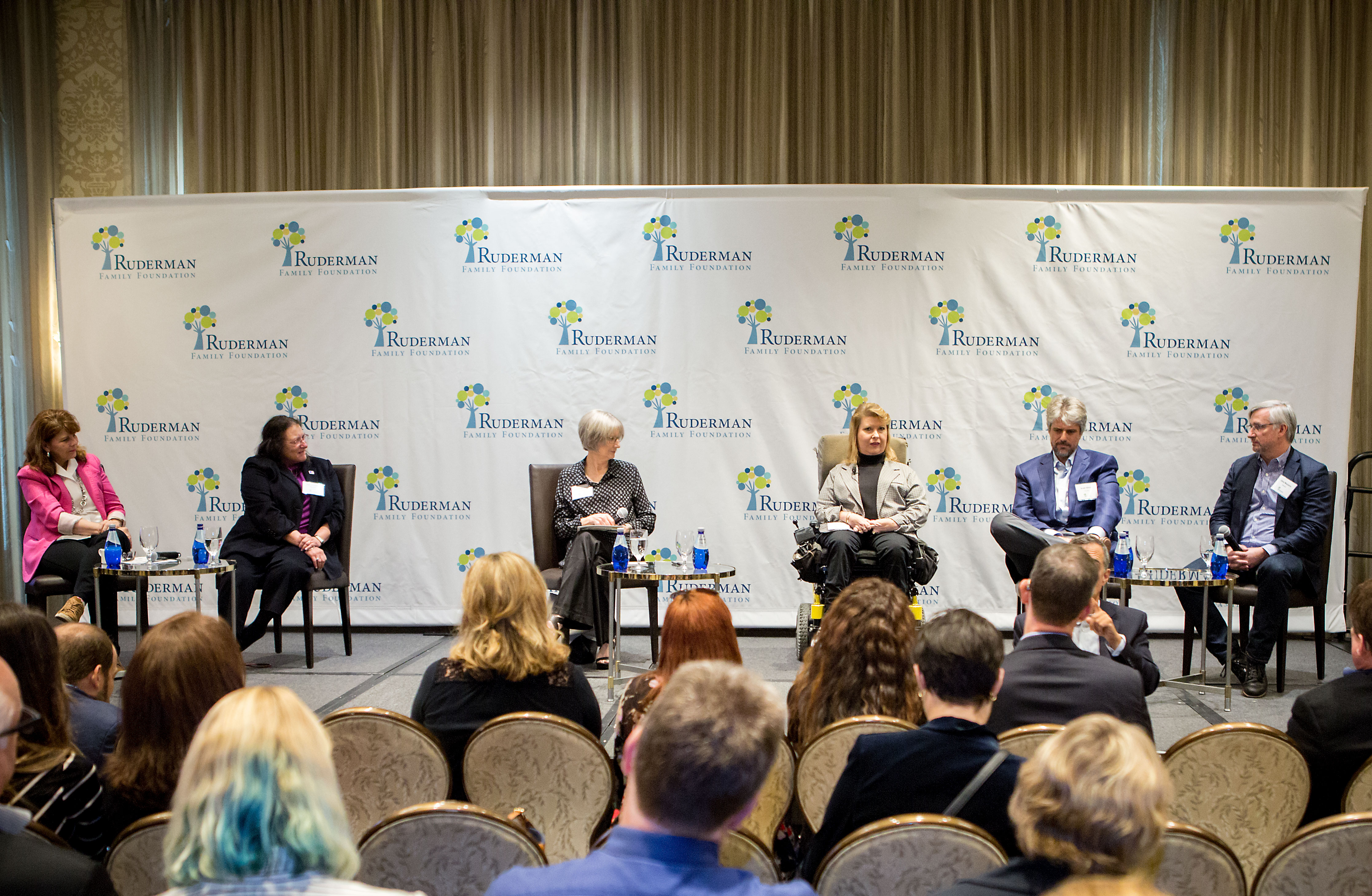Marlee Matlin laughs from behind a podium and pushes its microphone out of her way.
“I don’t need this,” she says and begins to sign the opening remarks of the Ruderman Studio-Wide Roundtable on Disability Inclusion, hosted by the Ruderman Family Foundation at the Four Seasons Hotel Los Angeles at Beverly Hills on Tuesday morning.
She’s witty and charming — what you’d expect of an Oscar-winning actress.

She demands attention and doesn’t beat around the bush when she drops downright infuriating facts — skills she’s honed as a deaf woman who’s experienced years of sexism, ableism and discrimination and who’s still fighting — despite being the youngest Academy Award Best Actress recipient — for her right to opportunity in Hollywood.
“I’m sad an event like this is necessary because there are 56 million Americans with disabilities. That is 20 percent of the population,” Matlin says, “but if you judged our existence by what you see on TV you would think we made up less than one percent.”
“In the 2016 season .9 percent [of characters on TV] had a disability,” she continues, “and when Danny Woodburn and Kristina (Kopic) did their work on White Paper they found 5 percent [of those roles] were played by actors with disabilities.”
“We are one‑fifth of the population, but we aren’t one‑fifth the percent on TV.”
Those stats lingered as actors took the stage for the first of two panels, “Achieving Visibility in Front of the Camera.” Speakers alongside Matlin included RJ Mitte, from “Breaking Bad;” Danny Woodburn, from “Seinfeld;” Jason George, from “Grey’s Anatomy;” Micah Fowler, from “Speechless;” and Orlando Jones, from “MadTV.” Robert David Hall, from “CSI: Crime Scene Investigation,” moderated.
“At first it was the idea that an actor with a disability would dare to think they could be a part of this business. A small group of actors, writers and other advocates have managed to shine a spotlight on people with disabilities,” Hall said before beginning the discussion. “We are part of any story that can be told, in front of the camera, behind it, under, over, inside, outside, I don’t care. I really love what activist Lawrence Carter says, ‘there is no diversity without us.’”

In the last year, Hollywood has scrambled to fix its diversity problem — but it’s left people with disabilities out of that inclusion. That affects you whether you realize it or not: everyone will be a part of the disability community in their lifetime. As we age, the likelihood that we will develop limitations only increases.
The fact that almost no disabled parts are given to disabled actors may never cross an able-bodied person’s mind. Actors are supposed to pretend to be people they’re not, right? Sure, but of late, when white actors play persons of color or straight actors play LGBTQ characters, the public responds. That’s not to say those two things don’t still happen (they do), but when the 2016 Oscar nominations came out, #OscarsSoWhite began, prompting the Academy to address its lack of diversity in a statement, part of which Matlin includes in her opening remarks:
In 2016, the [Academy’s] mandate is inclusion in all of its facets: gender, race, ethnicity and sexual orientation.
“Where is disability?” Matlin asked.
Woodburn, who co-authored the “Ruderman White Paper on Employment of Actors with Disabilities in Television,” published in July, said the problem continues when the press “blatantly overlooks disability.”
His point was being proven literally as he spoke.
Variety, a leading source in entertainment news, hosted an “Inclusion Summit” on the same day, at the same time, in the same city, as the Ruderman Roundtable. Disability was not included on the agenda, Matlin said, until advocates reached out and asked it be.
“They said they will have this big thing on diversity… but it was exclusive of people with disabilities,” Woodburn said. “We [the panelists] all went around and said, ‘Did you get invited?’ No, no, no… so we said, ‘You left something out,’ and they said, ‘Let’s ask a few.’”
The Mighty reached out to Variety for comment but has not yet heard back.
What happens when you leave disabled artists out of the conversation? A lot.
Throughout the day, speakers from both panels elaborated on the consequences of Hollywood’s exclusion of disabled people: You lose authenticity. You leave out narratives and experiences. You encourage the same problematic storylines. You discourage people with disabilities from pursuing careers in acting, writing, producing, directing, etc. You heighten unemployment of a group that, inside and outside of Hollywood, already deals with it more than the non-disabled population. You discriminate.
Let’s break some of that down.
1. You lose authenticity.
“If you make a choice to not go for the authenticity, the messenger is part of the point,” said George, who currently serves as chair of SAG-AFTRA’s national Diversity Advisory committee. When able-bodied actors are given opportunities (and later, awards) for roles disabled actors are more than qualified to play, the industry sends an underlying message: disabled people are dismissible, unimportant, invisible, a liability even.
In this part of the discussion, Matlin recalled a time when she auditioned for a role of a deaf woman her age, was led to believe she’d get the part, ultimately did not and then was asked to consult with the hearing actress who did get the role so her portrayal would be authentic.
“Most of my roles have been me calling the director or producer and saying, ‘This isn’t realistic,’” Woodburn said. (Multiple times, he’s had to tell colleagues it’s not authentic to have a little person bite someone else on the ass.) “I remember trying to get in on an audition and the feedback I got through my management was, ‘He could never be a doctor,’ which struck me because I happen to know the orthopedic surgeon at Johns Hopkins has achondroplasia (a form of dwarfism), and I didn’t get to audition… I think that spoke volumes behind casting people with disabilities.”
“We now call it ‘implicit bias’… a new term for ‘prejudice,’” George said. “If you are truly about equality, you are not just fighting for people that look like you. That should be the goal. Otherwise you are self-interested.”
“And authentic doesn’t mean we always play disabled characters,” Hall added. “If you are disabled and all you go out for is disabled roles, you won’t have a career.”
He’s right. Remember — only .9 of characters on TV in 2015 had a disability and many of those roles were not played by disabled actors.
During the second panel, Stacy Smith, Ph.D., Founder and Director of the Media, Diversity, and Social Change Initiative at the Annenberg School for Communication & Journalism at the University of Southern California, brought movies into this problem. In her research with Marc Choueiti and Dr. Katherine Pieper, Smith counted the number of speaking characters on screen in the top 100 grossing films of 2015. To be considered a “speaking character,” the character just had to say one word, which, as Smith pointed out, is a “very low bar.” Of the 100 films that featured 4,370 speaking characters, 48 films did not have a character with a disability and 84 of those 100 films did not have a female character with a disability. Sixty-one percent of the characters were featured with a physical disability, 37.1 percent with a mental or cognitive disability and 18.1 percent with a communicative disability. Only 2 percent of all characters with disabilities were shown in animated movies. Again, not all of these roles were played or voiced by actors with disabilities.
2. You leave out narratives and experiences.
This should bother Hollywood, but for some reason it doesn’t. Excluding disabled creatives means we’re missing out on damn good stories — stories anyone, disabled or not, would find moving, insightful, powerful, pick your adjective.
“Audiences want to see us and we want to be seen, and we deserve that,” Matlin said. “One‑fifth of the world looks like us, and it is time stories we tell reflect the diversity of the world we live in.”
This goes for behind the camera, too.
“It is important to join forces with other artists who are looking to have their stories told and do my role to have more interesting, different, compelling stories told,” Jones said.
3. You encourage the same problematic storylines.
Woodburn said leaving out disabled performers leaves room for movies like “Me Before You” to be made without anyone involved in the production process raising red flags. (If you’re unfamiliar with this, “Me Before You” is a book-turned-movie that stars an able-bodied actor as a disabled character who ultimately kills himself.) Able-bodied viewers then buy into this plot line, partly because it’s how disability is so often portrayed to them: as a tragedy. Hiring disabled creatives in all aspects of Hollywood would conversely allow the rich experiences of disabled people with all kinds of backgrounds to be told, not exclusively the ones that end in despair.
4. You discourage young people with disabilities from pursuing careers in acting, writing, producing, directing, etc.
This was brought up later in the afternoon when the second panel convened. “Achieving Visibility Behind the Camera” included Smith; Tari Hartman Squire of EIN SOF Communications; Jenni Gold, award-winning director and author of “The Gold Test;” Scott Silveri, executive producer of “Speechless;” and Glen Mazzara, the executive producer of A&E’s “Damien.” Gail Williamson, a talent agent and head of the Diversity Department at Kazarian/Measures/Ruskin & Associates, moderated.
Without role models, we risk telling disabled children and teens they have no shot at working in Hollywood. A lack of disabled people in the industry also sets the tone for the hiring process: if people with disabilities were hired more, they could rise to positions that allow them to hire more disabled creatives.
“Other minority groups have had people in the executive suites that help bring them in, people that worked in casting,” Gold said. “People with disabilities, they are not in the area that can bring people in.”
Mazzara said part of the solution would be if white guys “[got] their shit together.” (Mazzara is a white guy.) This means recognizing a problem and refusing to just accept the status quo.
“There is no representation, and there is little awareness, and I have to take a responsibility for myself as somebody who has been working in the industry for 20 years,” Silveri added. “More often than not, it is the same old white guys, over and over again… Diversity needs to include disability in a real way… and I think people need to see the benefit of more inclusion.”

5. You heighten unemployment.
According to The United States Bureau of Labor Statistics, in 2015, “the unemployment rate for persons with a disability was 10.7 percent — twice that of those with no disability.” This isn’t because disabled people don’t want to work. It’s because they aren’t given the same opportunities. Mirroring this in Hollywood only adds to the stigma that people with disabilities are all unable to work or are incapable of doing certain jobs.
Fowler pointed out why he thinks producers and directors are hesitant to work with disabled creatives. “They’re scared,” he said. “They have this mindset [that we] might not be able to do this or [we] might be too complicated for them, and I just want to say: give us a chance. Please.”
Mitte echoed this point, saying, “When companies look [at disability], they look at it as a liability. Both words have ‘ability’ in them. They miss out on what’s important.”
6. You discriminate.
Early on the panel of actors brought up the subject of access — how creatives with disabilities are blocked from auditions by lack of accommodations.(Accommodations, by the way, are basic human rights and are protected by the Americans With Disabilities Act.)
Fowler’s father told a story of having to carry his teenage son’s wheelchair up steps so he could audition. “What if you are alone in a wheelchair? Now what?” he asked.
No accessibility, once again, sends a message to disabled people, but more than that, it’s illegal.
Woodburn illustrated: “If I’m going to audition on a second floor with no elevator and it is for a character in the wheelchair, there was no intent for calling in an actor with a wheelchair.”
Matlin said a majority of casting directors don’t understand why she’d need an interpreter. “I have to go at length to explain,” she said, “and I have lost opportunities because of that, or miscommunication.”
“We are talking about a group of people that are invisible right now, that are treated like second class citizens,” Jones said. “If representation was equal, we wouldn’t be having this discussion… so there is human rights abuse, that’s what we are talking about.”
Discrimination, of course, isn’t new, and the disability community hasn’t been quiet about it. But when the press and Hollywood, two platforms that easily reach non-disabled people, reguarly ignore the exclusion of people with disabilities, we create a false sense of equality. When movies like “Me Before You” come out, when TV shows like “Glee” have a main character in a wheelchair (played by an able-bodied actor), a false sense of equality surfaces. A person outside of the disability community — though again, everyone will eventually be a part of the disability community in their lifetime — sees a wheelchair on screen and assumes equality has been achieved. The cycle continues.
Jay Ruderman, President of the Ruderman Family Foundation, told The Mighty in an email: “As Hollywood begins to come to terms that the entertainment industry needs to reflect modern day America, it is imperative that the largest minority among us, people with disabilities, is not left by the sidelines.”
So what can we do?
Gold said supporting shows and projects that support your own mission (she used “Speechless” as an example) will help bring change. That makes sense economically too (which execs obviously care about). “You need to be vocal and be on Twitter,” Gold said, “so people understand it is important.”
Acknowledging projects that are getting it right is a small but vital step in letting executives and studios know they have an audience starving for these types of stories.
Similarly, you can continue to be vocal when you don’t support a project.
“Me Before You” did well in the box office, but the disability community had an impact on its reception. Protests of the U.K. and U.S. premieres made mainstream media. Mark Johnson, chair of the Americans With Disabilities Act Legacy Project, told BuzzFeed News the traction of the protest was “unprecedented.” Squire and audience members said the film was pulled from “thousands” of theaters earlier than Warner Brothers planned. (When asked about this, a representative from Warner Brothers told The Mighty in an email: “False.”)
Still, the online conversation was loud. Blogs upon blogs were widely shared, and disability activists overtook a “Me Before You” Twitter chat that was ultimately cut short.
Behind the scenes, it’s critical to continue encouraging youth with disabilities to pursue careers in the industry. For those struggling to find work in Hollywood, Gold said persistence is key and she does whatever she has to do, even if that means making a project independently, to get her work out there.
“If you don’t see [disability], you don’t think about it, and it is a matter of informing and educating the rest of the industry,” Squire added. “Inclusion is a choice.”
Despite the infuriating stats and stories shared throughout both panels, no one in the room seemed discouraged or ready to give up the inclusion fight. In fact, the hundred or so attendees seemed more and more fired up as the day went on. Mitte acknowledged the frustration of slow progress but was optimistic that change is coming.
“We do fight. There is a battle going on every day. We have to breakdown this false sense of equality,” he said. “You have a voice, and people are fighting for you. It may be slow, but it is coming. Change will come.”
Disability-Inclusive Resources:
The below list, compiled by Squire, is not an exhaustive one, but it is a good place to start when looking for models and resources to help increase the presence and self-representation of people with disabilities in all aspects of the entertainment business.
- Breakdown Services/Actors Access (over 4,000 performers with disabilities)
- Changing the Face of Beauty
- Disability Film Challenge (open to aspiring filmmakers with disabilities)
- DisBeat (authentic disability sources for journalists)
- GLAAD Where We Are On TV: Annual Diversity Report
- Inclusion in the Arts (performers with disabilities and portrayals)
- LCA 2.0 Clinton Global Initiative (Commitment to Action)
- LCA.2.0/EIN SOF Communications (employment in front of and behind the camera/portrayals)
- Media Access Awards (November 18, 2016)
- Meet the Biz
- The Ruderman White Paper on the Employment of Actors with Disabilities in Television
- SAG-AFTRA Diversity Committees (including PwD)
- USC Annegberg 2016 Report: Inequality in 800 Popular Films: Examining Portrayals of Gender, Race/Ethnicity, LGBT and Disability from 2007-2015
- Writers Guild of America West — Diversity

